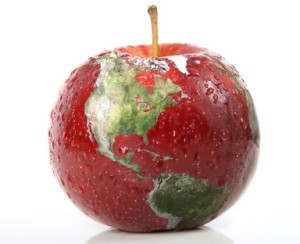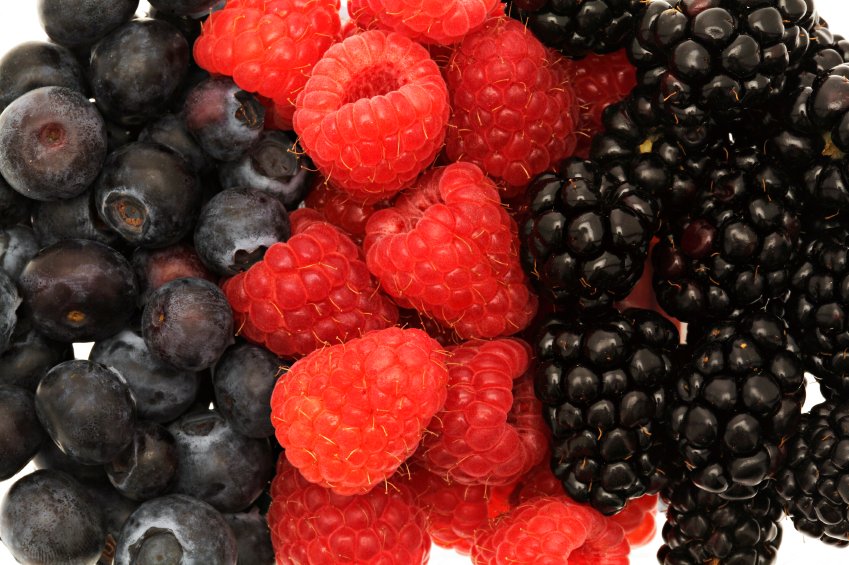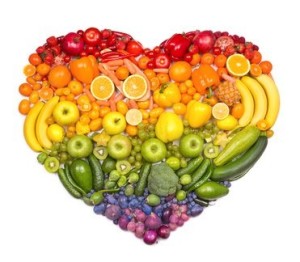Every 5 years the USDA and US Department of Health and Human Services publish updated dietary guidelines for the American public based on recommendations from the Dietary Guidelines Advisory Committee.
The Dietary Guidelines Advisory Committee (DGAC) is responsible for providing the US Federal government with current research-based evidence on diet, health, and nutrition, in a document titled the Scientific Report of the 2015 Dietary Guidelines Advisory Committee. From this report, the Federal government develops the Dietary Guidelines for Americans 2015, which will be released later this year.
For the first time in history, the DGAC has suggested that ‘health, dietary guidance, and the environment’ be considered in dietary choices and encourages people to focus their diet on whole natural plant foods including vegetables, fruit, nuts, seeds, legumes, etc. The committee especially emphasized the importance of the inclusion of vegetables and fruit in a healthy diet, which make up one-half of the current USDA MyPlate graphic.
The DGAC considers healthy plant-based diets to be more nutritious and of lower ‘environmental impact in terms of greenhouse gas emissions, land use, water use, and energy use’ than the average US diet. The committee acknowledges an overlap between health-promoting plant-based diets and reduced environmental impact. This connection has been a topic of discussion for many years in health circles, and now more than ever has become an especially timely topic given the current drought situation in many of the US western states, including California, where much of the food in the United States is grown.
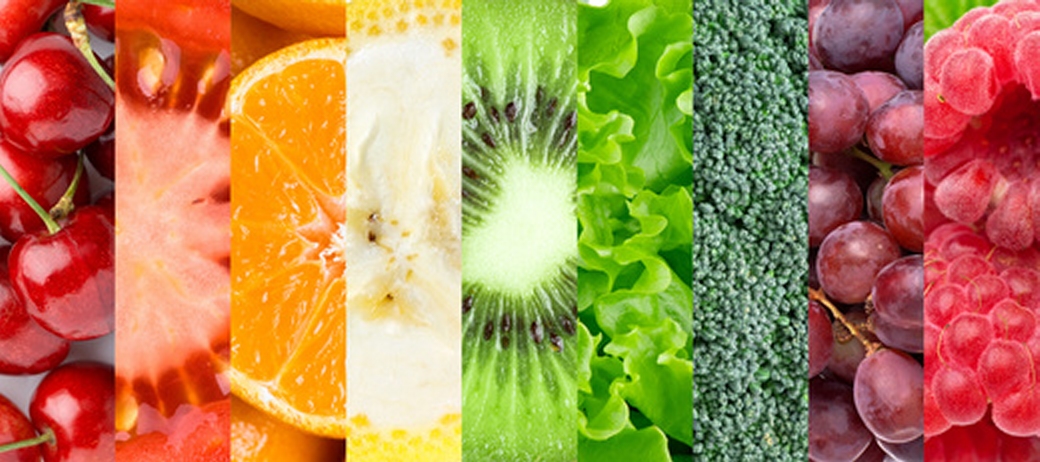
The committee recognizes that access to food is a major consideration and that ‘a sustainable diet ensures this access for both the current population and future generations.’ It is good to see that research-based strategies for producing enough food to feed our growing population healthfully and sustainably are beginning to get the attention of US policy makers. Intake of animal-based foods in the US is currently higher than the suggested plant-focused dietary patterns suggested by the committee. The committee is not necessarily asking people to completely give up any particular type of food, but rather to have a dietary emphasis on whole plant foods for both health and sustainability reasons.
It will be interesting to see the extent to which these plant-focused recommendations by the DGAC are reflected in the final Dietary Guidelines for Americans 2015. Regardless of the special interests that may have influence over the final document, I am happy to see that the DGAC makes their recommendations based on sound research and recognizes that the most health promoting diet is also the most environmentally sustainable. I am also pleased to see that the suggestions advocated by the committee are more aligned than ever with the information we teach in our online Mastering Raw Food Nutrition and Educator Course. For more class details, click here.
References and Research
Scientific Report of the 2015 Dietary Guidelines Advisory Committee:
http://www.health.gov/dietaryguidelines/2015-scientific-report/02-executive-summary.asp
http://www.health.gov/dietaryguidelines/2015-scientific-report/
One of the best ways to keep in touch with us is to join our email list. You’ll receive a free copy of Our Top 12 Strategies for Long Term Success on A Raw Plant-Based Diet eBook along with regular information about raw food and plant-based diets and periodic promotions for our classes, events, and other offerings!
5 Great Reasons to Add More Fruits and Vegetables to Your Diet
Raw fruits and vegetables are well-known for their health promoting benefits, so much that the current USDA MyPlate suggests that half of our diet be composed of fruits and vegetables. Here are many of the reasons why:
Vitamins
Fruits and vegetables contain many important and synergistic vitamins. Good examples include vitamins C and E. Many fruits and vegetables are excellent sources of vitamin C, including red bell peppers, strawberries, broccoli, cauliflower, papaya, lemons, tomatoes, cantaloupe, and of course, oranges. Leafy greens are rich in both vitamin C and vitamin E, and great sources include romaine lettuce, kale, mustard greens, dandelion greens, and collard greens.
Minerals
Bananas are famous for their potassium content, but fruits in general are great potassium sources. Dates, durian, apricots, honeydew melon, tangerines, oranges, peaches, nectarines, and mangoes are especially high in potassium.
Where do you get your calcium? Where do you get your iron? Many leafy greens can be rich sources of these important minerals, including kale, bok choy, dandelion greens, and even lettuce when eaten in quantity. Three cups of kale or dandelion greens provide over one quarter of the daily value for calcium and notable amounts of iron. A little-known fact is that some fruits can be notable sources of these two minerals as well. For example, only two valencia oranges or 5 figs provide 10% of the daily value for calcium. When eaten in greater quantities than this, as many raw food enthusiasts do, the calcium content can really add up. In regard to iron, although not as rich as leafy greens, mulberries, blackberries, and raspberries when eaten in quantity can provide notable amounts of this important mineral.
Phytonutrients
Plant foods in their fresh, raw state contain numerous phytonutrients, many of which can act as antioxidants which help protect our cells from age accelerating free radicals. Anthocyanins are antioxidants found in blue or purple foods such as blueberries and blackberries. Isothiocyanates are antioxidants found in cabbage family plants, also known as cruciferous vegetables, including collard greens, kale, bok choy, broccoli and Napa cabbage. Lutein and zeaxanthin are yellow-colored antioxidants, and are believed to play a role in protecting the macula of our eyes from damage caused by sunlight-induced free radicals. Lutein and zeaxanthin are found in foods such as dark leafy greens and yellow-orange fruits and vegetables, such as summer squash. Additional rich food sources include kale, Swiss chard, collard greens, romaine lettuce, broccoli, red bell peppers, dandelion greens, and zucchini.
Water
Water is involved in many essential body processes and makes up a significant percentage of body weight. In some raw food menus where fruits and vegetables make up the majority of foods eaten, the water content can be close to a gallon (almost 4 liters) or more! By comparison, raw menus that focus on denser more dehydrated foods, nuts, seeds, or oils can be less than half of this amount. Standard western menus are generally lower still at about one third the quantity of a high fruit and vegetable menu, creating the need for additional water consumption to meet daily needs. Unlike plastic water bottles, fruits and vegetables provide an abundance of healthy water in biodegradable containers!
Fiber
Dietary fiber is the indigestible portion of plant matter that is often referred to as roughage. Fiber plays critically important roles in various aspects of intestinal health, blood sugar and cholesterol regulation, and other important health benefits. Fiber keeps food moving though the intestines. It can help carbohydrates be digested more slowly, which in turn helps to stabilize blood sugar levels. It can bind to excess cholesterol in the digestive tract, helping keep blood cholesterol levels at an appropriate level. Fiber also plays a very important role in maintaining the health of the all-important human microbiome, as it provides food for healthy probiotic bacteria.
And the list goes on…
This is just the beginning! There are so many other reasons to include more fruits and vegetables in one’s diet and we are happy to see that the USDA now emphasizes the importance of these foods to the American public more than ever before.
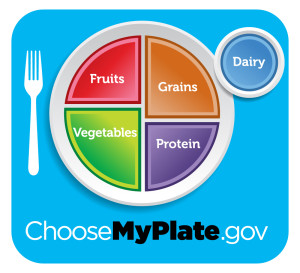
Posted in accordance with USDA MyPlate icon usage guidelines: The USDA does not endorse any products, services, or organizations.
One of the best ways to keep in touch with us is to join our email list. You’ll receive a free copy of Our Top 12 Strategies for Long Term Success on A Raw Plant-Based Diet eBook along with regular information about raw food and plant-based diets and periodic promotions for our classes, events, and other offerings!
Enhance Your Raw Food Diet with Home Grown Produce!
Spring is in the air and gardening season has begun in our home! Some of the many joys a raw food enthusiast experiences in Springtime are: preparing soil in raised beds to grow favorite garden vegetables, choosing the perfect vegetable starts, then planting them and watching them grow throughout the season. Harvest time is always exciting, too, as we reap the “fruits of our labor” (and the vegetables, too!).
Plant leafy greens for optimal nutrition
This year, in order to pack our raw vegan diet with optimal nutrition, we’ve planted a plenitude of leafy greens, including several types of lettuce, frisée (curly endive), dandelion greens, arugula, two types of kale, and two types of collard greens. The lettuce varieties we planted are heirloom varieties of green leaf, red leaf, red Romaine, green Romaine, and red oak leaf. Lettuce, frisée, and dandelion greens are all members of the sunflower family (Asteraceae), while arugula, kale, and collard greens are members of the cabbage family (Brassicaceae). Members of this plant family are also known as cruciferous vegetables, and include broccoli, cauliflower, maca, turnip, rutabaga, Brussels sprouts, watercress, red and green cabbage, bok choy, and Napa cabbage.
We’ve also planted several varieties of tomatoes, including some of the heirloom varieties we love, like Pineapple tomatoes, Cherokee Purple, Green Zebra, Brandywine, and several different types of cherry tomatoes. Several tomato varieties love heat, and we planted those in our yard on the south side of the house, which is warmer than the rest of our yard and more sheltered from the wind. Tomatoes are part of the nightshade family (Solanaceae) along with bell peppers, eggplant, potatoes, tomatillos, goji berries, Incan berries, jalapeño peppers, and other hot pepper varieties.
Plant mints in containers for best results
We have quite a few plants from the mint family in our yard this year, including several types of basil and four types of mint. Mints have a tendency to grow and spread prolifically. Early in my gardening career I made the mistake of planting mint in my raised beds and found out the hard way that mint plants have a tendency to “take over” the garden. This year, I learned from past experience and planted the mints in half wine barrels to keep them appropriately contained. However, if you want a very aromatic ground cover, Corsican Mint is a beautiful choice. A couple of years ago, I planted it in a makeshift herb garden in a non-grassy area of my yard. It has since spread and creates a deliciously fragrant chocolate mint addition to the area. It may surprise you to know that Chia seeds are another member of the mint family famously popular in the raw food community!
On the other hand, most types of basil stay localized in their growth habit, so I plant basil directly in my raised beds. They make a lovely companion planting next to the tomatoes, and the two are a perfect culinary combination, especially in Italian cuisine.
Fruit-bearing plants in our yard include two types of lemon trees and a fig tree, which is already producing numerous small figs. The fig tree is only five years old, and has already been producing numerous baskets of figs for the last three seasons. Since we adore figs, we’re really looking forward to harvest time later this year!
Plant fruits and vegetables no matter where you live
This is a small sampling of the foods we are currently growing in our yard and garden. We enjoy being able to create more diversity in our raw food diets and growing foods we enjoy that can be harder to find in the grocery store aisles. Even more importantly, we notice a big difference in the taste and quality of the foods we grow compared to the ones we buy. We suggest growing fruits and vegetables—you’ll be well rewarded in both taste and nutritional value. Before we had a back yard, we grew vegetables and fruits on our apartment patio, and sprouts, greens, and grasses near a window in our dining room. There are so many ways to grow your own food, and at harvest time, you’ll be grateful that you made the worthwhile effort. Happy gardening!
One of the best ways to keep in touch with us is to join our email list. You’ll receive a free copy of Our Top 12 Strategies for Long Term Success on A Raw Plant-Based Diet eBook along with regular information about raw food and plant-based diets and periodic promotions for our classes, events, and other offerings!
Is Lettuce a Superfood?
One of the best ways to keep in touch with us is to join our email list. You’ll receive a free copy of Our Top 12 Strategies for Long Term Success on A Raw Plant-Based Diet eBook along with regular information about raw food and plant-based diets and periodic promotions for our classes, events, and other offerings!
Nutrient Analysis of Kale
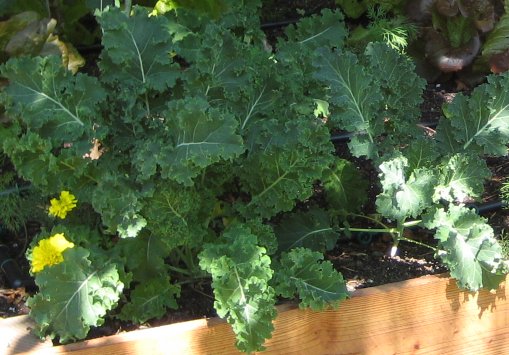
Kale is most certainly one of our many favorite leafy greens. When I first started enjoying the raw food approach to eating, I was not all that familiar with kale as a leafy green choice. At that time, I had only tried kale on handful of occasions and was not impressed with its (ahem) perceived bitter flavor 🙂
However, as I began my nutrition education, I found kale to be a fascinating leafy green that is packed with positive nutritional qualities:
| Nutrient | Kale (3 cups chopped, raw) | Adult Daily Values |
| Calories | 101 | |
| Protein | 6.6 | |
| Thiamin (Vitamin B1) | 0.22 | 1.1 – 1.2 mg |
| Riboflavin (Vitamin B2) | 0.26 | 1.1 – 1.3 mg |
| Niacin (Vitamin B3) | 2.01 | 14 – 16 mg |
| Pyridoxine (Vitamin B6) | 0.54 | 1.3-1.7 mg |
| Calcium | 271.4 | 1000 – 1200 mg |
| Iron | 3.42 | 8 – 18 mg |
| Magnesium | 68.3 | 310 – 420 mg |
| Potassium | 898.5 | 4700 mg |
| Zinc | 0.88 | 8 – 11 mg |
I found the vitamins B1, B2, B6, calcium, iron, magnesium, and potassium content of kale to be impressive. Nowadays, Rick and I enjoy kale in smoothies, juices, soups, and many other recipes. Since we like to have a variety of foods in our diet, we rotate our leafy greens to enjoy the diversity of flavors, textures, and nutrients offered by different leafy greens. For example, we might have kale as our main leafy green on one day, dandelion greens the next, frisée greens the next, and so forth.
On a side note, the kale that we grow in our garden is generally more tender and easier for us to digest than the kale we find in supermarkets. When the kale that we purchase has a “tougher” consistency we tend to blend it in a smoothie or even sometimes lightly steam it. We find that more tender kale from our garden is easily consumed raw in salads or other recipes.
There are so many leafy greens from which to choose when designing one’s diet. Do you have favorite leafy green?
One of the best ways to keep in touch with us is to join our email list. You’ll receive a free copy of Our Top 12 Strategies for Long Term Success on A Raw Plant-Based Diet eBook along with regular information about raw food and plant-based diets and periodic promotions for our classes, events, and other offerings!

